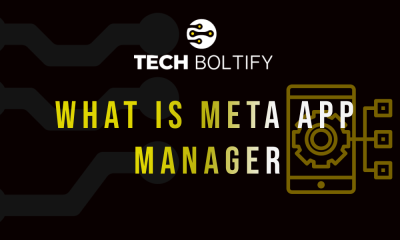Tech
Sustainable Manufacturing Automation: Reducing Waste and Energy Consumption
Want to slash your manufacturing waste while cutting energy costs?
Every manufacturer today is facing the same brutal challenge. You need to stay competitive while reducing your environmental impact. The good news?
Manufacturing automation isn’t just about efficiency anymore…
It’s becoming the secret weapon for sustainable operations.
Here’s what makes this even better…
Companies that embrace automated manufacturing processes are seeing dramatic results. A recent Deloitte study shows that 62% of manufacturers planned to use robotics and automation to improve efficiency in 2023.
But here’s the kicker:
Those choosing to automate saw a 30% higher average growth rate than businesses relying on manual processes.
What you’ll discover:
- Why Manufacturing Automation Is Your Sustainability Secret Weapon
- The Real Cost of Energy Waste in Manufacturing
- Smart Technologies That Cut Waste and Energy Consumption
- How AI and IoT Are Revolutionizing Green Manufacturing
Why Manufacturing Automation Is Your Sustainability Secret Weapon
Manufacturing automation is completely transforming how companies approach sustainability.
Here’s the thing: Traditional manufacturing processes are absolute energy hogs. Industry accounts for about one-third of all CO2 pollution, and the numbers are staggering when you look at waste.
But automation changes everything…
Smart manufacturing systems don’t just work faster—they work smarter. By integrating advanced Omega AI technologies into manufacturing automation systems, companies can monitor, analyze, and optimize every aspect of their production processes in real-time.
This means:
- Precise resource allocation: Automated systems use exactly what’s needed, when it’s needed
- Predictive maintenance: Equipment runs optimally and fails way less often
- Real-time monitoring: Instant detection of energy waste and inefficiencies
Consider this: 58% of manufacturers believe sustainability is essential to remain competitive.
They’re not wrong—sustainability isn’t just good for the planet anymore…
It’s becoming a business necessity.
The Real Cost of Energy Waste in Manufacturing
Let me show you something that’s going to shock you…
The U.S. manufacturing sector wastes more energy than it uses effectively. According to energy efficiency reports, a staggering 58% of energy is completely wasted.
That’s literally throwing money down the drain.
Think about what this means for your bottom line:
- Unnecessarily high utility bills
- Excessive carbon emissions
- Inefficient production processes
- Lost competitive advantage
But here’s where manufacturing automation becomes your game-changer…
Automated production lines optimize efficiency by minimizing human error, reducing downtime, and streamlining manufacturing processes. Companies implementing AI-powered energy management systems are seeing remarkable results.
Here’s a real example: One automotive manufacturer reduced energy consumption by 15% without any impact on output—simply by using smart systems to identify inefficiencies and adjust equipment settings in real-time.
Pretty impressive, right?
Smart Technologies That Cut Waste and Energy Consumption
Want to know the technologies that are making the biggest impact?
Let me break it down for you…
AI-Powered Predictive Analytics
Artificial intelligence isn’t just a buzzword anymore—it’s revolutionizing sustainable manufacturing.
AI systems analyze vast amounts of production data to predict when equipment will need maintenance, optimize energy usage patterns, and identify waste before it happens.
Here’s another real example: A large food processing company used machine learning to predict energy demand peaks and adjust production schedules accordingly.
The result? They took advantage of lower off-peak energy rates and reduced overall energy consumption by significant margins.
Industrial Internet of Things (IIoT)
Connected sensors and devices are creating smart factories that can monitor every aspect of production. These IIoT systems continuously monitor energy consumption at the machine level, identifying and correcting inefficiencies in real-time.
Here’s what one aerospace manufacturer achieved: They saw a 10% reduction in energy costs and a 15% improvement in overall equipment effectiveness after implementing IIoT-enabled energy management across their facilities.
Advanced Robotics and Automation
Modern robots do way more than just replace human workers—they optimize every single movement and process. Predictions show that 600,000 automation units will be installed globally this year alone, with many focusing specifically on sustainability improvements.
Automated production lines reduce waste by:
- Precision control: Exact material measurements and minimal overconsumption
- Quality consistency: Fewer defective products that end up as waste
- Optimized workflows: Smoother processes with fewer energy-intensive stops and starts
How AI and IoT Are Revolutionizing Green Manufacturing
The integration of AI and IoT technologies is creating unprecedented opportunities for sustainable manufacturing.
Here’s how it works:
Smart sensors can automatically control machinery and processes to limit energy consumption. These devices turn off machines that aren’t in use and collect data that measures efficiency, giving operators insights to adjust settings for optimal energy use.
Computer vision technology monitors inventory, products, and processes without additional sensors. It can assess production and find operations that don’t fit within acceptable time, quality, or quantity limits.
But here’s what most manufacturers don’t realize…
The biggest wins come from combining these technologies. When AI, IoT, and automation work together, they create a manufacturing ecosystem that continuously optimizes itself for both efficiency and sustainability.
It’s like having a self-improving factory.
Waste Heat Recovery Systems
Smart manufacturers are capturing and repurposing waste heat from their processes.
Here’s a perfect example: A brewery in Colorado implemented a waste heat recovery system that captures thermal energy from brewing and uses it to preheat water for subsequent cycles, reducing natural gas consumption by 20%.
Renewable Energy Integration
Automated systems can seamlessly integrate with renewable energy sources. Solar-powered manufacturing facilities are becoming more common, with some achieving 80% of their energy needs from on-site renewable generation during peak production hours.
The benefits are obvious: Lower energy costs, reduced carbon footprint, and enhanced brand reputation.
Making the Switch to Sustainable Manufacturing Automation
The transition to sustainable manufacturing automation doesn’t have to be overwhelming.
Here’s exactly what you need to do:
Step 1: Assess your current energy usage – Use automated monitoring systems to establish baselines and identify the biggest waste sources.
Step 2: Implement smart sensors – Begin with basic IoT devices that monitor energy consumption and equipment performance.
Step 3: Invest in predictive maintenance – AI-powered systems that prevent equipment failures and optimize performance.
Step 4: Optimize production scheduling – Use automation to run energy-intensive processes during off-peak hours when electricity is cheaper.
Here’s the key: You don’t have to automate everything at once. Many successful manufacturers start with one production line or process, prove the ROI, and then scale up.
It really is that simple.
The Future Is Automated and Sustainable
Manufacturing automation isn’t just about staying competitive anymore—it’s about building a sustainable future for your business and the planet.
Companies that embrace these technologies now are positioning themselves for long-term success. They’re cutting costs, reducing waste, minimizing their environmental impact, and often discovering that sustainable practices actually improve their bottom line.
The statistics don’t lie: automated manufacturing processes deliver measurable results in both efficiency and sustainability. With energy costs rising and environmental regulations tightening, there’s never been a better time to make the switch.
The question isn’t whether you should invest in sustainable manufacturing automation—it’s exactly how quickly you can get started. The future of truly successful manufacturing depends on making this critical transition today.
Tech
The Complete Guide to AI Comment Classification: Spam, Slander, Objections & Buyers
Meta ad comment sections are unpredictable environments. They attract a mix of users—some legitimate, some harmful, some automated, and some simply confused. For years, brands relied on manual review or simple keyword filters, but modern comment ecosystems require more advanced systems.
Enter AI comment classification.
AI classification engines evaluate language patterns, sentiment, intention, and user context. They categorize comments instantly so brands can prioritize what matters and protect what’s most important: trust, clarity, and conversion.
The Four Major Comment Types
1. Spam & Bots
These include cryptocurrency scams, fake giveaways, bot‑generated comments, and low‑value promotional content. Spam misleads users and diminishes ad quality. AI detects suspicious phrasing, repetitive patterns, and known spam signatures.
2. Toxicity & Slander
These comments contain profanity, hostility, misinformation, or attempts to damage your brand. Left unmoderated, they erode trust and push warm buyers away. AI identifies sentiment, aggression, and unsafe topics with high accuracy.
3. Buyer Questions & Objections
These represent your highest-value engagement. Users ask about pricing, delivery, sizing, guarantees, features, or compatibility. Fast response times dramatically increase conversion likelihood. AI ensures instant clarification.
4. Warm Leads Ready to Convert
Some comments come from buyers expressing clear intent—“I want this,” “How do I order?”, or “Where do I sign up?” AI recognizes purchase language and moves these users to the top of the priority stack.
Why AI Is Necessary Today
Keyword lists fail because modern users express intent in creative, informal, or misspelled ways. AI models understand context and adapt to evolving language trends. They learn patterns of deception, sentiment clues, emotional cues, and buyer intent signals.
AI classification reduces the burden on marketing teams and ensures consistent and scalable comment management.
How Classification Improves Paid Media Performance
• Clean threads improve brand perception
• Toxicity removal increases user trust
• Fast responses increase activation rate
• Meta rewards high-quality engagement
• Sales teams receive properly filtered leads
For brands spending heavily on paid social, classification isn’t optional—it’s foundational.
Tech
How To Bridge Front-End Design And Backend Functionality With Smarter API Strategy
Introduction: Building More Than Just Screens
We’ve all seen apps that look sharp but crumble the moment users push beyond the basics. A flawless interface without strong connections underneath is like a bridge built for looks but not for weight. That’s why APIs sit at the heart of modern software. They don’t just move data; they set the rules for how design and logic cooperate. When APIs are clear, tested, and secure, the front-end feels smooth, and the backend stays reliable.
The reality is that designing those connections isn’t just “coding.” It’s product thinking. Developers have to consider user flows, performance, and future scale. It’s about more than endpoints; it’s about creating a system that’s flexible yet stable. That mindset also means knowing when to bring in a full-stack team that already has the tools, patterns, and experience to move fast without cutting corners.
Here’s where you should check Uruit’s website. By focusing on robust API strategy and integration, teams gain the edge to deliver features user’s trust. In this article, we’ll unpack how to think like a product engineer, why APIs are the real bridge between design and functionality, and when it makes sense to call in expert support for secure, scalable development.
How To Define An API Strategy That Supports Product Goals
You need an API plan tied to what the product must do. Start with user journeys and map data needs. Keep endpoints small and predictable. Use versioning from day one so changes don’t break clients. Document behavior clearly and keep examples short. Design for errors — clients will expect consistent messages and codes. Build simple contracts that both front-end and backend teams agree on. Run small integration tests that mimic real flows, not just happy paths. Automate tests and include them in CI. Keep latency in mind; slow APIs kill UX. Think about security early: auth, rate limits, and input checks. Monitor the API in production and set alerts for key failures. Iterate the API based on real use, not guesses. Keep backward compatibility where possible. Make the API easy to mock for front-end developers. Celebrate small wins when a new endpoint behaves as promised.
- Map user journeys to API endpoints.
- Use semantic versioning for breaking changes.
- Provide simple, copy-paste examples for developers.
- Automate integration tests in CI.
- Monitor response times and error rates.
What To Do When Front-End and Backend Teams Don’t Speak the Same Language
It happens. Designers think in pixels, engineers think in data. Your job is to make a shared language. Start by writing small API contracts in plain text. Run a short workshop to align on fields, types, and error handling. Give front-end teams mocked endpoints to work against while the backend is built. Use contract tests to ensure the real API matches the mock. Keep communication frequent and focused — short syncs beat long meetings. Share acceptance criteria for features in user-story form. Track integration issues in a single list so nothing gets lost. If you find repeated mismatches, freeze the contract and iterate carefully. Teach both teams basic testing so they can verify work quickly. Keep the feedback loop tight and friendly; blame only the problem, not people.
- Create plain-language API contracts.
- Provide mocked endpoints for front-end use.
- Contract tests between teams.
- Hold short, recurring integration syncs.
- Keep a single backlog for integration bugs.
Why You Should Think Like a Product Engineer, Not Just A Coder
Thinking like a product engineer changes priorities. You care about outcomes: conversion, help clicks, retention. That shifts API choices — you favor reliability and clear errors over fancy features. You design endpoints for real flows, not theoretical ones. You measure impact: did a change reduce load time or drop errors? You plan rollouts that let you test with a small cohort first. You treat security, observability, and recoverability as product features. You ask hard questions: what happens if this service fails? How will the UI show partial data? You choose trade-offs that help users, not just satisfy a design spec. That mindset also tells you when to hire outside help: when speed, scale, or compliance exceeds your team’s current reach. A partner can bring patterns, reusable components, and a proven process to get you shipping faster with less risk.
- Prioritize outcomes over features.
- Measure the user impact of API changes.
- Treat observability and recovery as product features.
- Plan gradual rollouts and feature flags.
- Know when to add external expertise.
How We Help and What to Do Next
We stand with teams that want fewer surprises and faster launches. We help define API strategy, write clear contracts, and build secure, testable endpoints that front-end teams can rely on. We also mentor teams to run their own contract tests and monitoring. If you want a quick start, map one critical user flow, and we’ll help you design the API contract for it. If you prefer to scale, we can join as an extended team and help ship several flows in parallel. We stick to plain language, measurable goals, and steady progress.
- Pick one key user flow to stabilize first.
- Create a minimal API contract and mock it.
- Add contract tests and CI guards.
- Monitor once live and iterate weekly.
- Consider partnering for larger-scale or compliance needs.
Ready To Move Forward?
We’re ready to work with you to make design and engineering speak the same language. Let’s focus on one flow, make it reliable, and then expand. You’ll get fewer regressions, faster sprints, and happier users. If you want to reduce risk and ship with confidence, reach out, and we’ll map the first steps together.
Tech
Which SEO Services Are Actually Worth Outsourcing? Let’s Talk Real-World Wins
Okay, raise your hand if you thought SEO just meant stuffing keywords into blog posts and calling it a day. (Don’t worry, we’ve all been there.) Running a business comes with enough hats already, and when it comes to digital stuff, there’s only so much you can do on your own before your brain starts melting. The world of SEO moves quick, gets technical fast, and—honestly—a lot of it’s best left to the pros. Not everything, but definitely more than people expect. So, let’s go through a few of those SEO services you might want to hand off if you’re looking to get found by the right folks, minus the headaches.
Technical SEO—More Than Just Fancy Talk
If you’ve ever seen a message saying your website’s “not secure” or it takes ages to load, yeah, that’s technical SEO waving a big red flag. This stuff lives under the hood: page speed, mobile-friendliness, fixing broken links, and getting those little schema markup things in place so search engines understand what the heck your pages are about.
You could spend hours (days) learning this on YouTube or DIY blogs, but hiring a specialist—someone who does this all day—saves you a load of stress and guesswork. Sites like Search Engine Journal dig into why outsourcing makes sense, and honestly, after one too many late-night plugin disasters, I’m convinced.
Content Writing and On-Page Optimization (Because Words Matter)
Let’s not dance around it: great content still rules. But search-friendly content is a different beast. It needs to hit the right length, work in keywords naturally, answer genuine questions, and actually keep visitors hooked. Outsourcing writing, especially to someone who actually cares about your brand’s tone, is worth it for most of us.
On-page SEO, which is tweaking all those little details like titles, descriptions, internal links, and image alt text, is a time-eater. It’s simple once you get the hang of it, but when you’re trying to grow, outsourcing makes the most sense.
Link Building—Trickier Than It Looks
Here’s where things get a bit spicy. Backlinks are essential, but earning good ones (not spammy or shady stuff) takes relationship-building, tons of outreach, and real patience. You can spend all month sending emails hoping someone will give your guide a shout-out, or you can just hire folks with connections and a process. Just watch out for anyone promising “hundreds of links for dirt cheap”—that’s usually a shortcut to trouble.
Local SEO—Getting Seen in Your Own Backyard
Ever tried showing up for “pizza near me” only to find yourself on page 7? Local SEO isn’t magic, but it takes a special touch: optimizing your Google Business Profile, gathering reviews, and making sure your info matches everywhere. It’s honestly a job in itself, and most small teams find it way easier to have a local SEO pro jump in a few hours a month.
Reporting and Analytics—Don’t Go Blind
Last, don’t skip out on real reporting. If nobody’s tracking what’s working—and what’s not—you’re just flying blind. Outsourced SEO pros come armed with tools and real insights, so you can see if your money’s going somewhere or just swirling down the drain.
Wrapping Up—Be Realistic, Outsource Smarter
You’re good at what you do, but SEO is more like ten jobs rolled into one. Outsource the parts that zap your time or make your brain itch, and keep what you enjoy. Focus on the wins (more leads, higher rankings, fewer headaches), and watch your business get the attention it deserves.
-
Tech1 year ago
AI and Freight Management
-

 Tech2 years ago
Tech2 years agoLPPe Service Android App and its Functions – How to Remove it
-

 Tech1 year ago
Tech1 year agoWhat is a Permission Controller – Control Manager Notifications
-

 Tech2 years ago
Tech2 years agoWhat is Device Keystring App On Android
-

 Tech2 years ago
Tech2 years agoWhat is Carrier Hub – How to Resolve Processing Requests Issues
-

 Tech2 years ago
Tech2 years agoWhat is Summit IMS Service – How to Stop Syncing on Your Android Device
-

 Tech2 years ago
Tech2 years agoMeta App Manager – What is Meta App Installer
-

 Tech2 years ago
Tech2 years agoWhat is Cameralyzer Samsung – How to Fix or Uninstall Cameralyzer on Android

